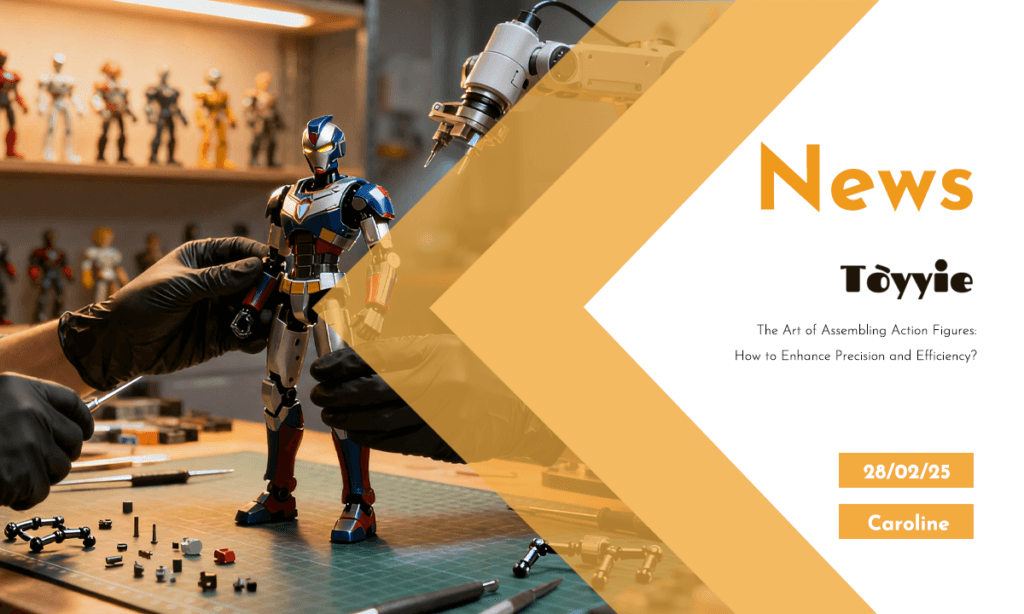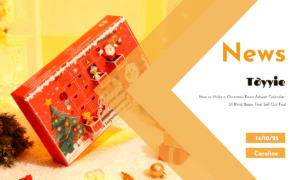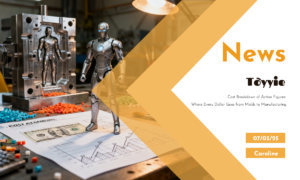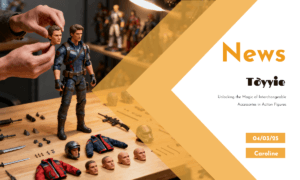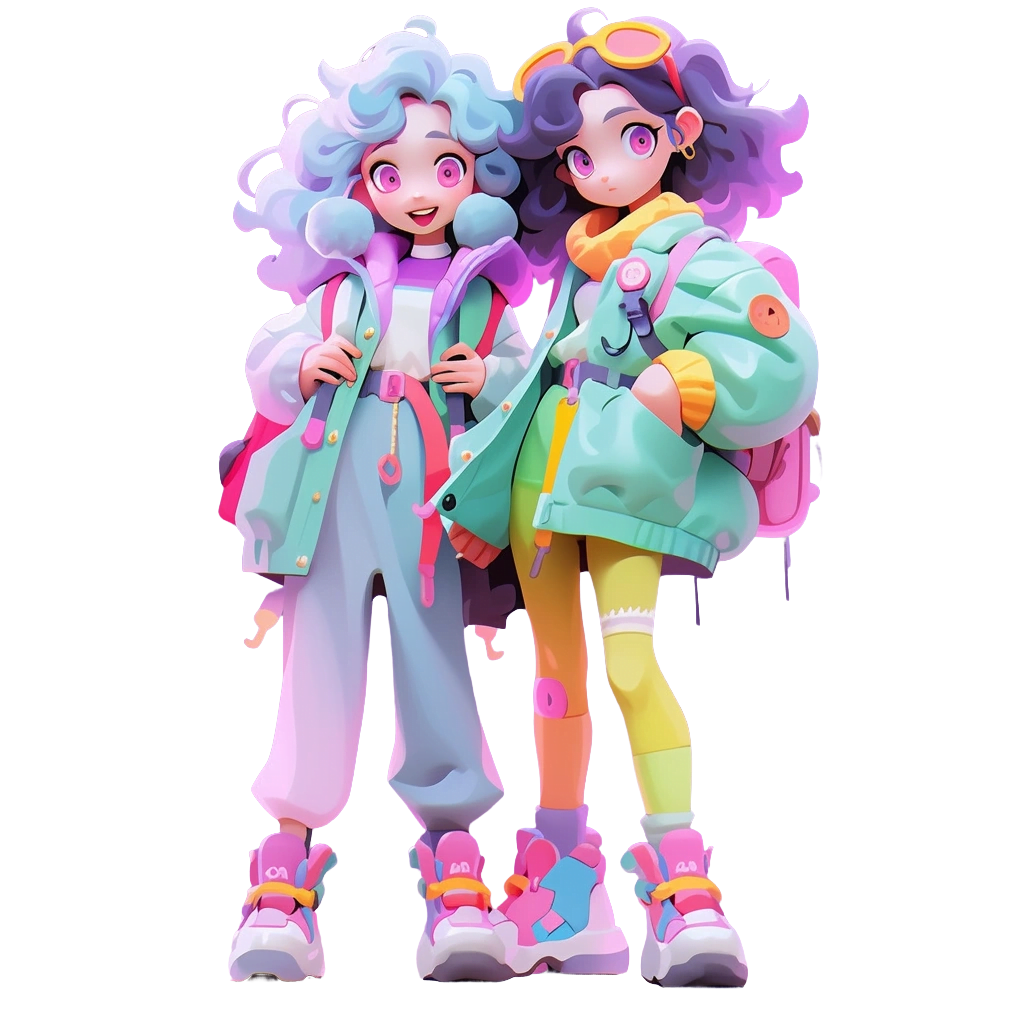📌 Introduction📌
In the vibrant world of collectible toys, action figures stand out as a pinnacle of craftsmanship and creativity. These aren’t just toys; they are intricate pieces of art that capture the essence of characters from movies, comics, and video games. As someone who has spent years navigating the complexities of toy manufacturing, I’ve come to appreciate the delicate balance between precision and efficiency in assembling these beloved figures. Each action figure is a testament to the skill and dedication poured into its creation, making the assembly process both an art and a science.
The assembly of action figures involves a series of meticulous steps, each crucial to ensuring the final product meets the high standards expected by collectors and enthusiasts alike. From my experience, one of the primary challenges we face is achieving the perfect alignment of parts. Whether it’s the articulation points that allow for poseability or the seamless integration of accessories, every component must fit together with precision. This requirement for exactness often clashes with the need for speed in production, especially when dealing with limited edition releases where time is of the essence.
Moreover, the complexity of modern action figures adds another layer of difficulty. Today’s figures are not just static models but dynamic representations that include multiple points of articulation, interchangeable parts, and sometimes even electronic components. Ensuring that all these elements work harmoniously without compromising the structural integrity of the figure is a daunting task. It requires not only advanced manufacturing techniques but also a deep understanding of material properties and mechanical engineering principles.
Efficiency in assembly is equally critical. In an industry where trends can shift overnight, the ability to quickly adapt and produce high-quality figures is invaluable. However, rushing the process can lead to mistakes—misaligned joints, improperly attached accessories, or even structural weaknesses that could affect the longevity of the product. Balancing the need for speed with the demand for quality is a constant challenge that keeps us on our toes.
Through my journey in this field, I’ve learned that overcoming these challenges is not just about having the right tools or technologies. It’s about fostering a culture of excellence and continuous improvement within our teams. It’s about understanding that every small detail matters and that the success of our products hinges on the collective effort of everyone involved in the assembly process. By sharing insights into these challenges, I hope to provide you with a deeper appreciation of the craftsmanship behind your favorite action figures and perhaps inspire you to look at them with new eyes.
In the following sections, I will delve deeper into specific difficulties encountered during the assembly of action figures and explore practical solutions that have proven effective in our operations. Whether you’re a fellow industry professional or simply a fan curious about the magic behind these miniature masterpieces, I invite you to join me on this exploration of precision and efficiency in action figure assembly.
🛠️ Common Challenges in Action Figure Assembly: Precision and Efficiency
As we delve deeper into the intricacies of action figure assembly, it becomes evident that achieving both precision and efficiency is no small feat. Over the years, I’ve encountered numerous challenges that test the limits of our production capabilities and require innovative solutions to overcome. Let me walk you through some of the most common hurdles we face in the assembly line and how they impact our daily operations.
1️⃣ Part Misalignment
One of the foremost issues is part misalignment. Imagine meticulously crafting each component of an action figure, only to find that during assembly, the arms don’t quite fit into their sockets or the head wobbles awkwardly. This misalignment not only affects the aesthetic appeal of the figure but also its functionality. Collectors expect their figures to be poseable and stable, and any deviation from this expectation can lead to dissatisfaction. I recall a particular instance where a batch of figures had slightly off-center hip joints, making them unable to stand upright. The repercussions were immediate—returns spiked, and online forums buzzed with complaints. It was a stark reminder of how critical precision is in every step of assembly.
2️⃣ Adhesive Failures
Another significant challenge is adhesive failures. Many action figures rely on adhesives to hold certain parts together, especially those with intricate designs or movable components. However, if the adhesive doesn’t bond properly, parts can become loose over time or even fall off entirely. This issue is particularly problematic with smaller accessories like weapons or detachable armor pieces. I remember a project where the adhesive used for a sword attachment failed under stress testing. The sword would detach during vigorous play, which was unacceptable for a product marketed as durable and reliable. Addressing this required not only switching to a stronger adhesive but also redesigning the attachment mechanism to ensure better grip and longevity.
3️⃣ Component Damage
Component damage during assembly is another frequent obstacle. Given the delicate nature of many parts, especially those made from softer plastics or featuring fine details, the risk of breakage or scratching is high. This is compounded by the fast-paced environment of assembly lines, where speed is often prioritized over caution. A memorable incident involved a series of figures with highly detailed facial features. During assembly, several units suffered scratches on the faces due to mishandling, rendering them unsellable. This not only resulted in financial losses but also delayed the release, affecting our market positioning.
These challenges underscore the delicate balance we must maintain between precision and efficiency. On one hand, we strive for perfection in every assembled piece, knowing that even minor flaws can lead to major setbacks. On the other hand, the pressure to meet production deadlines and keep costs manageable often pushes us to accelerate processes, increasing the risk of errors. It’s a constant tug-of-war that demands not only technical expertise but also strategic foresight and adaptability.
Reflecting on these experiences, I realize that overcoming these challenges is not just about implementing stricter quality controls or investing in better equipment. It’s about fostering a mindset of continuous improvement and innovation within our teams. It’s about empowering our assembly line workers with the skills and knowledge to identify potential issues early and address them proactively. By sharing these insights, I hope to illuminate the complexities of action figure assembly and inspire solutions that enhance both the precision and efficiency of our production processes.
🔧 Innovative Solutions to Enhance Precision in Action Figure Assembly
Navigating the complexities of action figure assembly requires more than just addressing the challenges; it demands innovative solutions that elevate the precision of each piece we create. Through years of hands-on experience, I’ve witnessed firsthand how adopting advanced tools, refining training programs, and implementing rigorous quality control measures can transform our production processes. Let me share some of the strategies that have proven instrumental in enhancing the precision of our action figures, ensuring that each piece not only meets but exceeds the expectations of discerning collectors.
1️⃣ Precision Tools and Machinery
One of the most impactful advancements we’ve embraced is the integration of precision tools and machinery. Investing in high-quality, specialized equipment has been a game-changer in our assembly line. For instance, we introduced computer numerical control (CNC) machines for cutting and shaping intricate parts. These machines offer unparalleled accuracy, allowing us to produce components with exact specifications consistently. I recall a project where the introduction of CNC machining significantly reduced the incidence of part misalignment. The precision achieved meant that joints fit perfectly, and accessories snapped into place without any wobble or looseness. This technological upgrade not only improved the quality of our figures but also streamlined the assembly process, reducing the time spent on manual adjustments.
2️⃣ Enhanced Training Programs
Enhanced training programs for assembly line workers have also played a crucial role in boosting precision. Recognizing that skilled labor is the backbone of our operations, we revamped our training modules to focus on the latest assembly techniques and quality standards. We implemented a mentorship program where experienced artisans guided newer team members, sharing tips and tricks honed over years of practice. One memorable initiative involved hands-on workshops where workers practiced assembling complex figures under simulated conditions. This practical approach not only sharpened their skills but also fostered a culture of excellence and attention to detail. The results were tangible—fewer errors, higher consistency, and a noticeable improvement in the overall quality of our output.
3️⃣ Rigorous Quality Control
Rigorous quality control measures further reinforce our commitment to precision. We adopted a multi-tiered inspection process that scrutinizes every aspect of the assembly, from raw materials to the finished product. One innovative technique we implemented is the use of 3D scanning technology, which allows us to detect even the minutest discrepancies in shape and size. This technology proved invaluable when a subtle imbalance in a figure’s stance was detected, which could have gone unnoticed otherwise. Correcting these issues early in the production cycle prevents costly recalls and preserves our brand’s integrity. Moreover, we established a feedback loop where inspectors and assembly line workers collaborate to identify recurring issues and implement corrective actions swiftly.
4️⃣ Modular Assembly Techniques
Additionally, embracing modular assembly techniques has enhanced both precision and flexibility in our production. By designing components that can be easily interchanged or adjusted, we minimize the risk of errors during assembly. For example, we developed a standardized joint system that allows for seamless integration across different figure models. This modularity not only simplifies the assembly process but also enables quick adaptations to design changes based on feedback from early prototypes. The ability to swiftly implement changes kept our projects on track and within budget, ensuring that we could respond dynamically to market demands.
In conclusion, enhancing precision in action figure assembly is a multifaceted endeavor that requires a blend of advanced technology, skilled labor, and stringent quality assurance. By integrating precision tools, enhancing training programs, and implementing rigorous quality control measures, we can achieve a level of craftsmanship that resonates with collectors worldwide. These strategies not only uphold our brand’s reputation for excellence but also ensure that each action figure we produce is a testament to our dedication to quality and innovation.
🚀 Streamlining Assembly Processes for Enhanced Efficiency
While precision remains paramount in action figure assembly, achieving efficiency is equally vital to sustain competitive advantage and meet market demands. In my years overseeing production lines, I’ve discovered that streamlining assembly processes not only accelerates output but also enhances overall productivity without compromising quality. Here, I will share some practical strategies that have effectively boosted our operational efficiency, ensuring that our production remains agile and responsive.
1️⃣ Optimized Workflow Layouts
One of the first steps towards greater efficiency is optimizing workflow layouts. By analyzing the flow of materials and personnel through our facilities, we identified bottlenecks that slowed down production. Rearranging workstations to minimize unnecessary movements and streamline access to tools and components significantly reduced assembly times. For instance, grouping related tasks together allowed workers to complete sequences without backtracking, which not only sped up the process but also reduced fatigue. This reorganization was particularly beneficial during peak production seasons when meeting tight deadlines was crucial.
2️⃣ Automation
Automation plays a pivotal role in enhancing efficiency, especially in repetitive tasks. We invested in robotic systems for tasks such as painting and attaching small components, which traditionally consumed considerable manpower and time. These robots operate with consistent speed and accuracy, drastically reducing the margin for error and freeing up skilled workers for more complex assignments. A notable example was the implementation of robotic arms for applying uniform paint layers on figures’ armor. This not only improved the finish quality but also cut down the painting time by nearly half, allowing us to allocate resources more effectively.
3️⃣ Lean Manufacturing Principles
Lean manufacturing principles have also been instrumental in our quest for efficiency. By adopting practices such as just-in-time production and minimizing waste, we have been able to reduce inventory costs and improve cash flow. Training our teams in lean methodologies encouraged a mindset focused on eliminating non-value-adding activities. For example, by standardizing parts and using universal connectors, we reduced the variety of components needed, which simplified inventory management and expedited assembly processes. This approach not only streamlined operations but also enhanced our ability to scale production up or down based on demand fluctuations.
4️⃣ Continuous Improvement Culture
Furthermore, fostering a culture of continuous improvement has driven our efficiency initiatives. Regular brainstorming sessions and feedback loops involving all levels of staff have led to numerous process enhancements. Encouraging employees to suggest improvements and rewarding innovative ideas created a proactive environment where efficiency was everyone’s responsibility. One successful initiative came from a suggestion by an assembly line worker to pre-assemble certain components off the main line, which shaved minutes off each unit’s assembly time and cumulatively saved hours across batches.
5️⃣ Technology Integration
Technology integration extends beyond automation to include data analytics and real-time monitoring systems. By leveraging software that tracks production metrics, we gained insights into performance trends and identified areas for improvement. Real-time data allowed us to make informed decisions quickly, adjusting workflows or reallocating resources as needed to maintain optimal efficiency. This tech-driven approach ensured that we remained agile and could swiftly adapt to any disruptions in the supply chain or shifts in consumer preferences.
In summary, enhancing efficiency in action figure assembly involves a strategic blend of optimized workflows, automation, lean practices, and a culture of continuous improvement. By implementing these strategies, we not only accelerated our production capabilities but also maintained the high standards of quality that our brand is known for. This dual focus on efficiency and quality positions us strongly in the competitive toy market, enabling us to deliver exceptional products that captivate collectors and enthusiasts alike.
⚖️ Achieving the Balance: Precision and Efficiency in Action Figure Assembly
Throughout my career in the toy manufacturing industry, I’ve come to realize that the true art of assembling action figures lies in striking the perfect balance between precision and efficiency. Reflecting on the insights shared earlier—from tackling common assembly challenges and implementing innovative solutions to enhancing precision and streamlining processes—I am reminded of the profound interplay between these elements. Each decision made in the assembly process reverberates through the lifecycle of the product, influencing everything from initial consumer reception to long-term brand loyalty.
Precision and efficiency are not isolated goals but intertwined facets that dictate the success of action figure assembly. Effective precision management does not merely involve meticulous craftsmanship; it encompasses smart allocation of resources, strategic adoption of technology, and optimized workflow designs. These practices ensure that quality constraints do not impede the pursuit of speed in toy manufacturing. On the flip side, stringent efficiency protocols safeguard the brand’s reputation, ensuring that each piece not only meets but exceeds the expectations of discerning collectors.
The real magic happens when precision and efficiency converge to support each other. For instance, investing in high-quality tools and skilled labor might seem costly upfront, but it pays off by reducing defect rates and enhancing product durability. This not only minimizes returns and complaints but also elevates customer satisfaction, which is priceless in the competitive world of collectibles. Similarly, adopting advanced technologies like automation for repetitive tasks might require an initial capital outlay, yet it streamlines the production process and enhances consistency, ultimately saving costs in the long run.
Moreover, the strategies discussed are not mere theoretical constructs but practical tools that have proven effective in real-world scenarios. They empower manufacturers to navigate the complexities of action figure assembly with confidence. By integrating these strategies, companies can achieve a harmonious balance where precision fuels efficient production, and high-quality output justifies the investment, creating a virtuous cycle of success.
In conclusion, the journey of assembling action figures is fraught with challenges, but it is also ripe with opportunities for those willing to innovate and adapt. By embracing a holistic approach that marries precision with efficiency, manufacturers can not only survive but thrive in this niche market. As we continue to push the boundaries of what’s possible in toy manufacturing, let us carry forward these lessons, ensuring that each action figure we create is not just a product, but a testament to our commitment to excellence and passion for the art of toy making.
By reflecting on these comprehensive strategies and their impacts, we reinforce the notion that in the realm of action figure assembly, achieving a balance between precision and efficiency is not just beneficial—it is essential for sustained success and innovation.

